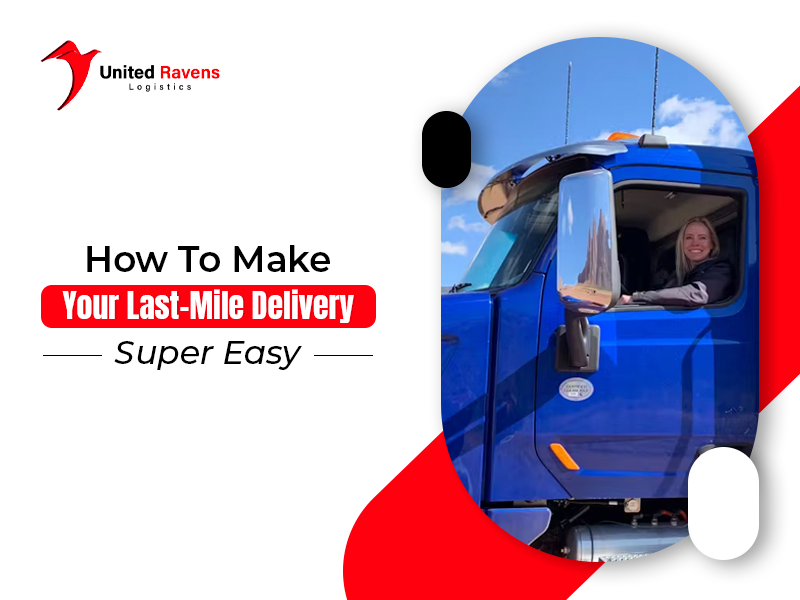With the immense growth of the logistics industry, customer demand and expectations about last-mile delivery have also grown exponentially. Customers seek to track their shipments in real-time and want to know when their cargo will arrive.
Due to this, effective last-mile delivery has become more important and challenging. In this blog, we will see what it is and how you can overcome it.
What is Last Mile Delivery?
It refers to the final step in the delivery process, where the shipment is transported from a transportation hub or distribution center to its ultimate destination, typically the customer’s business location. This last leg of the journey is often the most time-consuming and costly part of the entire delivery process, accounting for a significant portion of the total shipping costs.
How do you handle last-mile delivery challenges?
Overcoming last-mile delivery challenges is crucial for businesses to ensure customer satisfaction and operational efficiency. The last-mile delivery process can be complex and riddled with obstacles. Here are four solutions to help overcome these challenges:
Optimize Route Planning
Efficient route planning is essential for last-mile delivery operations. By leveraging advanced routing software and real-time data, businesses can optimize delivery routes, reducing travel time and fuel costs. These tools can account for traffic patterns, construction zones, and other factors that may cause delays, enabling delivery personnel to take the most efficient routes to their destinations. Additionally, dynamic route optimization can help adjust routes on the fly, accommodating changes in demand or unexpected circumstances.
Implement Real-Time Tracking
Real-time tracking technology can provide businesses with visibility into the entire last-mile delivery process. By equipping delivery vehicles with GPS tracking devices and integrating them with a centralized platform, businesses can monitor the location and status of each delivery in real-time.
This information can be used to provide accurate estimated time of arrival (ETA) updates to customers, improving their overall experience. Additionally, real-time tracking can help identify potential bottlenecks or delays, allowing businesses to take proactive measures to mitigate disruptions.
Leverage Mobile Technology
Mobile technology can streamline last-mile delivery operations by providing drivers with easy access to critical information and enabling seamless communication. Mobile apps can provide turn-by-turn navigation, delivery instructions, and customer data, reducing the chances of errors or delays. Furthermore, mobile apps can facilitate electronic proof of delivery, eliminating the need for paper-based processes and improving overall efficiency.
Explore Alternative Delivery Options
Traditional last-mile delivery methods may not always be the most efficient or cost-effective solution. Businesses can explore alternative delivery options, such as crowdsourced delivery services, which leverage a network of independent contractors to complete deliveries. This approach can be especially useful during peak periods or in areas with high delivery volumes.
By implementing these solutions, businesses can overcome the challenges associated with them, improve operational efficiency, reduce costs, and enhance customer satisfaction.
FAQs
The final phase of the delivery process can be significantly complex. You want to make sure that your customer receives the shipment promptly. You want to hire a professional 3PL logistics company or make sure your customers receive their shipments properly. Click here
Here are some frequently asked questions related to the last-mile delivery of shipments that can help you improve your last-mile delivery.
What is most important for last-mile delivery success?
The most crucial factor in its success is providing an exceptional customer experience. In today’s competitive landscape, customers expect fast, reliable, and transparent delivery services. Meeting or exceeding these expectations is paramount for building customer loyalty and fostering repeat business. Efficient routing, real-time tracking, timely communication, and flexible delivery options are all essential components that contribute to a positive last-mile delivery experience for customers.
How can you make your last-mile delivery efficient?
To make it efficient, businesses should leverage technology and data-driven strategies. Implementing route optimization software can help plan the most efficient routes, reducing travel time and fuel costs. Real-time tracking systems provide visibility into delivery operations, enabling proactive problem-solving and accurate ETAs for customers.
Additionally, utilizing mobile apps and electronic proof of delivery can streamline processes and eliminate paper-based inefficiencies. Exploring alternative delivery methods like crowdsourcing or click-and-collect options can also enhance efficiency in specific scenarios or high-volume areas.
Conclusion
Customer retention is increasingly focused on personal experience and the challenges customers face while collecting their shipments. To make sure you have better retention and revenue, you must crack the code for effective last-mile delivery.
So, if you are a logistics company and face challenges regarding it or want to make sure your cargo delivery is successful, do check out the blog above to improve your last-mile delivery.
Also, Read this: https://unitedravens.com/understanding-8-common-causes-of-shipping-delays-and-how-to-prevent-them/

